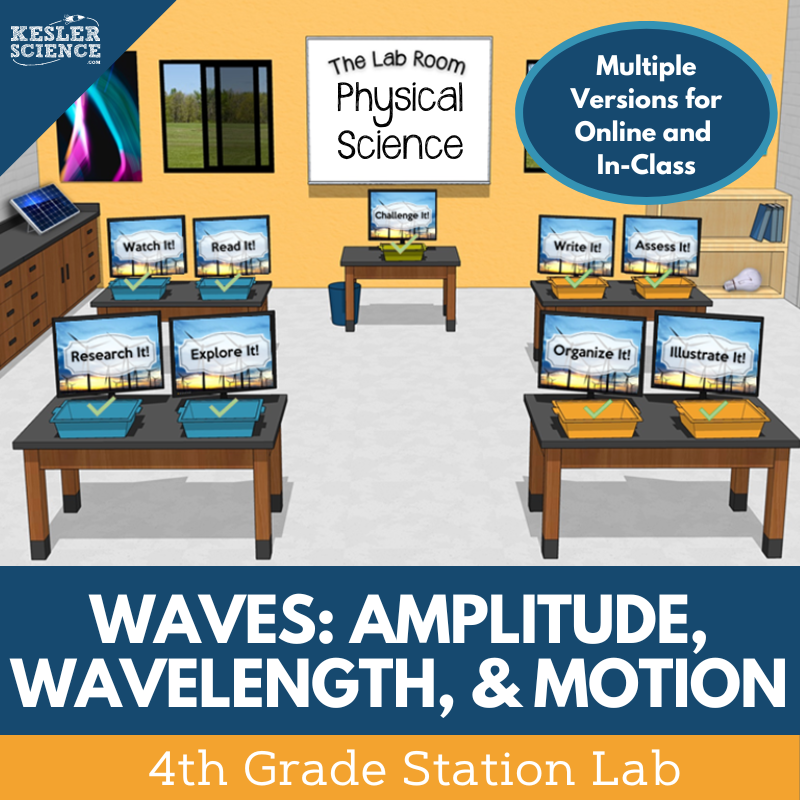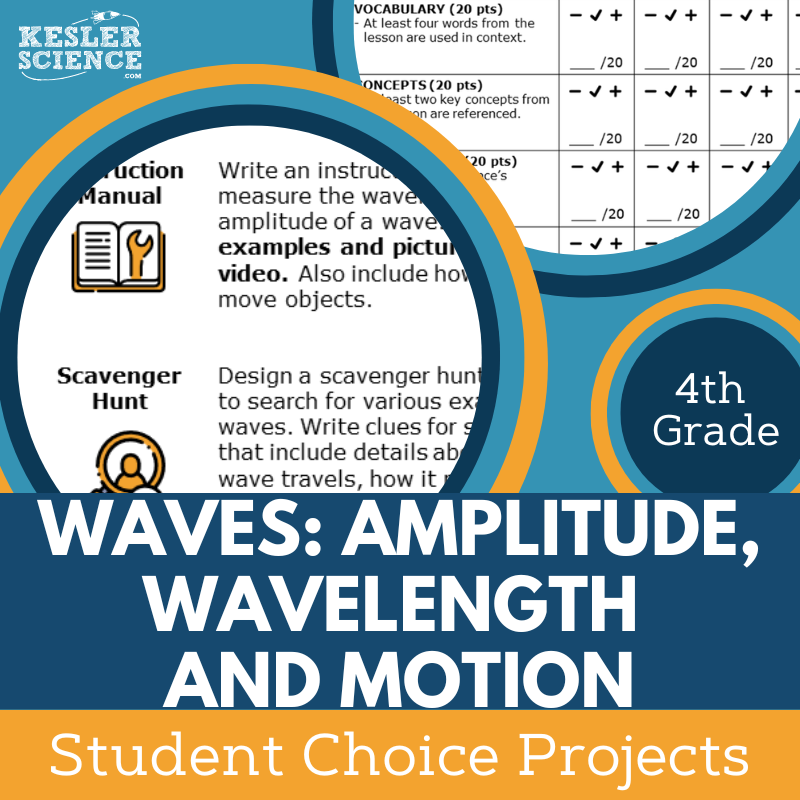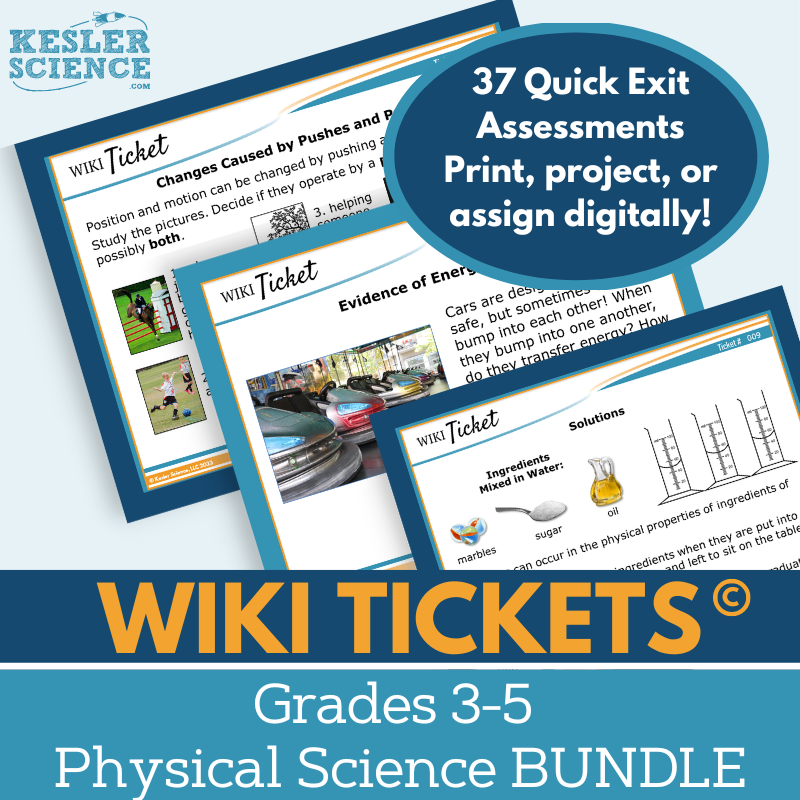Modeling Waves Activities for 4th Grade Science
This engaging 5E lesson on waves guides students in exploring amplitude, wavelength, and motion through a variety of interactive and student-led activities. The resources below will give students a comprehensive understanding of waves. All of the following materials are also included in the Kesler Science Membership.
The Kesler Science Waves: Amplitude, Wavelength, and Motion 5E Lesson is a comprehensive, student-led unit on waves, covering amplitude, wavelength, and motion. This physical science lesson includes presentations, worksheets, choice projects, and assessments, all fully editable for flexibility. Designed for multimodal learning, the lesson offers differentiated materials, Spanish translations, and both digital and printable formats.
Students explore wave concepts through a differentiated, hands-on station lab featuring activities like hands-on demos, reading comprehension, research, video discussions, categorization exercises, writing prompts, illustration tasks, and assessments. A bonus station provides enrichment for early finishers. Explanation resources include editable PowerPoints, interactive notebook templates, and note-taking guides. Students extend their learning through choice projects, while assessment options include updated STAAR 2.0 questions, review worksheets, and modified versions for diverse needs.
Aligned with NGSS 4-PS4-1 and Texas TEKS, this low-prep, high-engagement lesson follows the 5E Model, covering Engagement, Exploration, Explanation, Elaboration, and Evaluation. The materials are designed for both in-class and virtual learning, ensuring maximum flexibility for educators.
The Kesler Science Waves: Amplitude, Wavelength, and Motion 5E Lesson is a comprehensive, student-led unit on waves, covering amplitude, wavelength, and motion. This physical science lesson includes presentations, worksheets, choice projects, and assessments, all fully editable for flexibility. Designed for multimodal learning, the lesson offers differentiated materials, Spanish translations, and both digital and printable formats.
Students explore wave concepts through a differentiated, hands-on station lab featuring activities like hands-on demos, reading comprehension, research, video discussions, categorization exercises, writing prompts, illustration tasks, and assessments. A bonus station provides enrichment for early finishers. Explanation resources include editable PowerPoints, interactive notebook templates, and note-taking guides. Students extend their learning through choice projects, while assessment options include updated STAAR 2.0 questions, review worksheets, and modified versions for diverse needs.
Aligned with NGSS 4-PS4-1 and Texas TEKS, this low-prep, high-engagement lesson follows the 5E Model, covering Engagement, Exploration, Explanation, Elaboration, and Evaluation. The materials are designed for both in-class and virtual learning, ensuring maximum flexibility for educators.
Engage your 4th-grade students with this student-led station lab on waves, exploring amplitude, wavelength, and motion. Designed for hands-on and virtual learning, the lesson encourages students to develop models to describe wave patterns and understand how waves can cause objects to move.
Students interact with the material through nine differentiated stations, featuring videos, readings, research, and hands-on tasks. They demonstrate learning by organizing information, illustrating models, writing responses, and completing assessments. A challenge station offers extension activities, and English and Spanish reading passages support differentiated learning.
This low-prep, high-engagement resource promotes active learning and critical thinking, making it ideal for upper elementary science classrooms.
Engage your 4th-grade students with this student-led station lab on waves, exploring amplitude, wavelength, and motion. Designed for hands-on and virtual learning, the lesson encourages students to develop models to describe wave patterns and understand how waves can cause objects to move.
Students interact with the material through nine differentiated stations, featuring videos, readings, research, and hands-on tasks. They demonstrate learning by organizing information, illustrating models, writing responses, and completing assessments. A challenge station offers extension activities, and English and Spanish reading passages support differentiated learning.
This low-prep, high-engagement resource promotes active learning and critical thinking, making it ideal for upper elementary science classrooms.
The Waves, Amplitude, Wavelength, and Motion Student Choice Projects give fourth-grade students the opportunity to showcase their understanding through a variety of project options. A project page outlines six student-led choices plus a “design your own” project, with an editable rubric for teacher, peer, or self-assessment.
These flexible, multimodal projects allow students to demonstrate learning in creative ways. Two versions of the project page support differentiation, with a modified version offering targeted options for students needing remediation and challenge opportunities for advanced learners. Teachers can adjust the rubric to fit grading needs.
The projects require common classroom supplies such as paper, markers, and scissors, though many can also be completed digitally.
The Waves, Amplitude, Wavelength, and Motion Student Choice Projects give fourth-grade students the opportunity to showcase their understanding through a variety of project options. A project page outlines six student-led choices plus a “design your own” project, with an editable rubric for teacher, peer, or self-assessment.
These flexible, multimodal projects allow students to demonstrate learning in creative ways. Two versions of the project page support differentiation, with a modified version offering targeted options for students needing remediation and challenge opportunities for advanced learners. Teachers can adjust the rubric to fit grading needs.
The projects require common classroom supplies such as paper, markers, and scissors, though many can also be completed digitally.
The Waves: Amplitude, Wavelength, and Motion science writing activity engages 4th grade students in testing their knowledge of waves through an interactive “A Day in the Life” story model. This print-or-digital exercise enhances science reasoning and writing skills while supporting both in-person and virtual learning.
Aligned with TEKS and NGSS 4-PS4-1, this low-prep, student-centered activity includes teacher directions with rubrics, a projection version, full-sized and half-sheet handouts, and a digital interactive version in PowerPoint or Google Slides. Ideal for cross-curricular connections, pre-test assessments, student choice projects, early finisher activities, extra credit, make-up work, and differentiation, this writing prompt fosters engagement and science literacy.
The Waves: Amplitude, Wavelength, and Motion science writing activity engages 4th grade students in testing their knowledge of waves through an interactive “A Day in the Life” story model. This print-or-digital exercise enhances science reasoning and writing skills while supporting both in-person and virtual learning.
Aligned with TEKS and NGSS 4-PS4-1, this low-prep, student-centered activity includes teacher directions with rubrics, a projection version, full-sized and half-sheet handouts, and a digital interactive version in PowerPoint or Google Slides. Ideal for cross-curricular connections, pre-test assessments, student choice projects, early finisher activities, extra credit, make-up work, and differentiation, this writing prompt fosters engagement and science literacy.
The WIKI Tickets© Physical Science Set provides engaging, flexible formative assessments for 3rd–5th grade science. This set includes 37 exit tickets, each available in five formats: a full-screen projection version, three printable handouts, and an interactive digital version compatible with PowerPoint and Google Slides.
Aligned with NGSS and TEKS standards, these assessments cover key physical science topics, including forces and motion, energy transformations, evidence of energy transfer, circuits, mixtures, and waves amplitude, wavelength, and motion. Each standard has at least one ticket, and some topics feature multiple assessments. A bonus table of contents file is included to show alignment.
WIKI Tickets© can be used in both in-person and virtual learning settings. Students can respond on printed handouts, their own paper, or digitally in a 1:1 or remote environment. These colorful, engaging assessments work as exit tickets, bellringers, or quick checks to gauge student understanding at any time.
The WIKI Tickets© Physical Science Set provides engaging, flexible formative assessments for 3rd–5th grade science. This set includes 37 exit tickets, each available in five formats: a full-screen projection version, three printable handouts, and an interactive digital version compatible with PowerPoint and Google Slides.
Aligned with NGSS and TEKS standards, these assessments cover key physical science topics, including forces and motion, energy transformations, evidence of energy transfer, circuits, mixtures, and waves amplitude, wavelength, and motion. Each standard has at least one ticket, and some topics feature multiple assessments. A bonus table of contents file is included to show alignment.
WIKI Tickets© can be used in both in-person and virtual learning settings. Students can respond on printed handouts, their own paper, or digitally in a 1:1 or remote environment. These colorful, engaging assessments work as exit tickets, bellringers, or quick checks to gauge student understanding at any time.
Year-Round Resources
These year-round activities will increase your students' understanding of many middle school science topics. All of these activities are also included in the Kesler Science Membership.
Visual Data & Graphing
You're not alone if your students struggle with understanding graphs, charts, and tables. It's a skill that takes an enormous amount of practice. This resource will help students build a strong foundation in analyzing data and creating their own data visualizations.
Bell Ringers and Warm-Ups
These middle school science bell ringers are an excellent way to engage your students as soon as they walk into your classroom. This comprehensive FULL YEAR resource includes everything you need to start off each science class with an interesting warm-up activity.
Review Board Games
Each game board has been carefully designed to keep students engaged. There are 10 different action spaces on each board and dozens of question cards. All of the actions are related to science concepts and keep the students motivated throughout the game.
Each game is ready to play. Simply print out the board and the cards and let the students enjoy reviewing nine different units.
Essential Questions and Standards
Below are the essential questions and standards associated with the lessons and activities included in the modeling waves unit. This topic is only one of more than 100 middle school science topics included in the Kesler Science Membership.
-
How can we model the similarities and differences between waves?
-
What evidence shows that waves can cause objects to move?
-
NGSS - 4-PS4-1 Modeling Waves
Kesler Science Membership
Imagine never having to search for another middle school science lesson again. The membership gives you access to ALL of the Kesler Science products in one place (Yes, including everything above).
Say goodbye to long hours of lesson prep.











